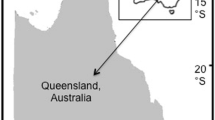Abstract
One of the central issues of behavioral ecology focuses on the probability of detecting multiple paternity in a scenario of polygamy. The main problem for this kind of analysis arises in species with large number of offspring in the same litter and large population sizes in which only a small fraction of progeny and females can be analyzed. Here, we present a method to estimate the statistical power to detect multiple paternity for these species. Since calculations involved handling of very large numbers, Ramanujan’s approximation to factorials was used to make them possible in the R software. We exemplified this method using features observed in crabs; (i) females carry thousands or millions of embryos per brood, (ii) typically less than 50% of females show multiple paternity, and (iii) high contribution of a single male (>90%) in a brood. Genetic parental analysis assumes the use of loci that allow maximal discrimination among individuals. The results showed that the number of females sampled is an important point to be considered to detect multiple paternity with high statistical power. Comparisons of different numbers of sampled females and embryos showed that 20 larvae from 50 females present satisfactory statistical power even when all males except the main contributor sired a modest number of embryos and only a small proportion of females showed embryos sired by more than one male. The proposed method can improve the sampling design in order to reach sufficient levels of statistical power when testing for multiple paternity in species with high fecundity, a common characteristic in both terrestrial and aquatic environments.
Significance statement
To detect multiple paternity in highly fertile species, researchers commonly use the probability of detecting multiple mating (PrDM). Although the PrDM is a powerful tool to detect multiple paternity in a litter/brood/clutch, this analysis neglects the estimation of the statistical power at the population level. Here, we developed an analytical method to assess the statistical power to detect multiple paternity considering brood size and the number of females sampled in a population. The model tested with 1,000,000 of embryos per brood (as in marine crabs), different numbers of embryos per brood, and different numbers of females analyzed reached values of statistical power greater than 99% when the first male sired 90% of the progeny and 50% of females had multiple paternity. This analysis showed the importance of focusing on the experimental unit in the experimental design in studies where multiple paternity is being tested.

Similar content being viewed by others
Change history
19 December 2016
An erratum to this article has been published.
References
Baggio RA, Pil MW, Boeger WA, Patella LA (2011) Genetic evidence for multiple paternity in the mangrove land crab Ucides cordatus (Decapoda: Ocypodidae). Mar Biol Res 7:520–524
Birkhead TR, Moller AP (1995) Extra-pair copulation and extra-pair paternity in birds. Anim Behav 49:843–848
Cobbs G (1977) Multiple insemination and male sexual selection in natural populations of Drosophila pseudoobscura. Am Nat 111:641–656
Daly-Engel TS, Grubbs RD, Holland KN, Toonen RJ, Bowen BW (2006) Assessment if multiple paternity in single litters from three species of carcharhinid sharks in Hawaii. Environ Biol Fish 76:419–424
Griffith SC, Owens IPF, Thuman KA (2002) Extra pair paternity in birds: a review of interspecific variation and adaptive function. Mol Ecol 11:2195–2212
Hines AH (1991) Fecundity and reproductive output in nine species of Cancer crabs (Crustacea: Brachyura: Cancridae). Can J Fish Aquat Sci 48:267–275
Jensen PC, Bentzen P (2012) A molecular dissection of the mating system of the Dungeness crab, Metacarcinus magister (Brachyura: Cancridae). J Crust Biol 32:443–456
Jossart Q, Wattier R, Kastally C, Aron S, David B, De Ridder C, Rigaud T (2014) Genetic evidence confirms polygamous mating system in a crustacean parasite with multiple hosts. PLoS One 9:e90680
Kichler K, Holder MT, Davis SK, Márquez R, Owens DW (1999) Detection of multiple paternity in the Kemp’s ridley sea turtle with limited sampling. Mol Ecol 8:819–830
Koga T, Henmi Y, Murai M (1993) Sperm competition and the assurance of underground copulation in the sand-bubbler crab Scopimera globosa (Brachyura: Ocypodidae). J Crust Biol 13:134–137
McKeown NJ, Shaw PW (2008) Single paternity within broods of the brown crab Cancer pagurus: a highly fecund species with long-term sperm storage. Mar Ecol Progr Ser 368:209–215
Neff BD, Pitcher TE (2002) Assessing the statistical power of genetic analyses to detect multiple mating in fishes. J Fish Biol 61:739–750
Pardo LM, Riveros MP, Fuentes JP, Rojas-Hernandez N, Veliz D (2016) An effective sperm competition avoidance strategy in crabs drives genetic monogamy despite evidence of polyandry. Behav Ecol Sociobiol 70:73–81
R Core Team (2015) R: a language and environment for statistical computing. R Foundation for Statistical Computing, Vienna, Austria. URL http://www.R-project.org/
Reaney L, Maurer G, Backwell PY, Linde C (2012) Paternity analysis of two male mating tactics in the fiddler crab, Uca mjoebergi. Behav Ecol Sociobiol 66:1017–1024
Rojas-Hernández N, Veliz D, Pardo LM (2014) Use of novel microsatellite markers for population and paternity analysis in the commercially important crab Metacarcinus edwardsii (Brachyura: Cancridae). Mar Biol Res 10:839–844
Sainte-Marie B, Gosselin T, Sévigny J-M, Urbani N (2008) The snow crab mating system: opportunity for natural and unnatural selection in a changing environment. Bull Mar Sci 83:131–161
Say L, Pontier D, Natoli E (1999) High variation in multiple paternity of domestic cats (Felis catus L.) in relation to environmental conditions. Proc Roy Soc Lond B 266:2071–2074
Shuster SM, Wade MJ (2003) Mating systems and strategies. Princeton University Press, Pinceton, NJ, 522 pp
Shuter SM, Briggs WR, Dennis PA (2013) How multiple mating by females affects sexual selection. Philos Trans R Soc Lond Ser B Biol Sci 368:20120046
Uller T, Olsson M (2008) Multiple paternity in reptiles: patterns and processes. Mol Ecol 17:2566–2580
Acknowledgements
DV thanks the financial support of Basal Grant PFB 023, ICM P05-002, and Millennium Nucleus NC120030. NRH thanks the IEB Master Thesis Fellowship. LMP thanks the financial support of the FONDECYT 1150388 and FONDAP-IDEAL 15150003. We thank Dr. Stephan Shuster and anonymous reviewers for constructive comments to the early version of this manuscript.
Author information
Authors and Affiliations
Corresponding author
Additional information
Communicated by T. Breithaupt
An erratum to this article is available at https://doi.org/10.1007/s00265-016-2258-0.
Rights and permissions
About this article
Cite this article
Veliz, D., Duchesne, P., Rojas-Hernandez, N. et al. Statistical power to detect multiple paternity in populations of highly fertile species: how many females and how many offspring should be sampled?. Behav Ecol Sociobiol 71, 12 (2017). https://doi.org/10.1007/s00265-016-2240-x
Received:
Revised:
Accepted:
Published:
DOI: https://doi.org/10.1007/s00265-016-2240-x




